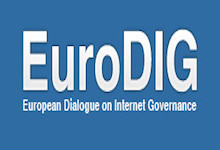Domain names innovation and competition
8 Jun 2017 02:00h
Event report
Opening the session, co-moderators Mr Dirk Krischenowski, dotBERLIN GmbH & Co. KG, and Ms Maarja Kirtsi, Estonian Internet Foundation/.ee, explained that the discussion will focus on issues related to innovation and competition on the domain name market, especially in the context of new generic top-level domains (gTLDs), launched by the Internet Corporation for Assigned Names and Numbers (ICANN) in 2014.
To kick-start the debates, Krischenowski gave an overview of a study conducted by ICANN on competition, consumer trust, and consumer choice in the domain name market. Some of the main findings of the study: new gTLDs contributed to the growth of the market; the sales channel integrated the new gTLDs quickly and lead to much greater consumer choice; many new registrar operators entered the market, especially in former under-developed markets; the number of registry operators increased by a factor of 60; typical TLDs are niche, targeted, and geographic TLDs. Overall, the New gTLD Program has lead to a dramatic increase in consumer choice, a modest increase in competition, and minimal impact on consumer trust.
Ms Elena Plexida, European Commission (EC), talked about the evaluation and revision process that the EC has launched with regard to the regulations for the .eu TLD. She explained that the .eu TLD was formally established by Regulation 733/2002, while EC Regulation 874/2004 set the rules for the registry and the .eu. The .eu TLD was delegated by ICANN in 2005. As the market has continuously changed, these regulations have become outdated, have generated administrative challenges and need a revision. Issues to be analysed during the evaluation process include: whether the .eu objectives have been achieved (to boost e-commerce and empower end-users to create a European digital identity), the legal separation between registry and registrars, whether the registry should be more active in other Internet governance areas (and how).
Mr Jörg Schweiger, DENIC e.G./.de outlined one issue of concern for the domain name industry: How to make sure that domains do not subsurface, in the sense that they exist from a technical point of view, but users are not really aware of them? The industry has been constantly looking for the ‘killer application’ to address this issue. He pointed out that one way to make domain names more attractive could be to build on the discussions about self-determination, sovereignty, and identity. The main objective of .de now is to retain as many domain names as possible, and that the direction the registry is growing in is not necessarily related to innovation per se, but rather to having a secure domain name space.
Ms Lianna Galstyan, Internet Society Armenia, said that the .am registry never had an objective to have a high number of domain name registrations, but rather, to give the community the possibility to register domain names under .am. The same rationale was also behind the launch of the Armenian Internationalised Domain Name (IDN).
Mr Ardi Jürgens, Zone Media OÜ, pointed out that domain names do not exist in a bubble; they are part of a system which includes resources and applications. A healthy growth in the demand for domain names could result in applications and people using domain names for creating value, either for them or society. In the search for a ‘killer application’, the industry should look at young people and try to find a way to create value for them within the domain name space. Compared to social media platforms, domain names have the main advantage of being under the control of the registrant, and this is something that the industry should try to communicate better.
Mr Andrea Beccalli, ICANN, discussed examples of innovation in the DNS, such as the new gTLDs, the introduction of IDN TLDs, and the DNS Security Extensions (DNSSEC). Even the community work on developing the rules and processes for the New gTLD Program can be seen as a form of innovation. Schweiger, however, argued that the new round of gTLDs does not necessarily means innovation, as it was simply presenting what was on the market already – TLDs. Moreover, most business models surrounding new gTLDs are similar to what had been on the market before their introduction, with only a few exceptions.
Security in the domain name space was mentioned during the discussions as an area that deserves more attention. There are troubling correlations between new gTLDs and ‘innovation in crime’, and there are service providers who have blocked all new gTLDs from their servers due to security concerns. Innovation on the security front should be a priority for new gTLDs. Privacy is also an issue that requires increased attention, as users are more and more demanding in this regard.
The risk of cybersquatting was also raised as an issue of concern for new gTLDs, with regard to the protection of trademarks. It was said that the current protection mechanisms (such as the sunrise period allowing trademark holders to register relevant domain names, and mechanisms for rights enforcement post domain name registration) are helpful, but not sufficient. Such issues are currently analysed within the ICANN framework.
At the end of the session, a point was raised – that it is not actually clear what is innovative in the domain name space, as TLDs have been in place for many years and they are basically the same ‘technology’ or ‘tool’ that they have been since the creation of the DNS.
Related topics
Related event

